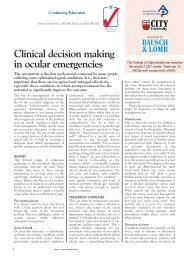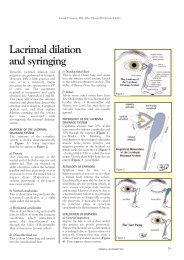Intraocular lens implantation - Optometry Today
Intraocular lens implantation - Optometry Today
Intraocular lens implantation - Optometry Today
Create successful ePaper yourself
Turn your PDF publications into a flip-book with our unique Google optimized e-Paper software.
Sponsored by<br />
Module 3 Part 11<br />
Multiple choice questions<br />
<strong>Intraocular</strong> <strong>lens</strong> <strong>implantation</strong><br />
Please note there is only one correct answer<br />
1. All of the following statements concerning<br />
aphakic spectacle and contact <strong>lens</strong>es are<br />
correct except?<br />
a. Image magnification with aphakic<br />
spectacles is 50%<br />
b. Distortions with aphakic spectacles<br />
include ring scotoma<br />
c. Image magnification with aphakic contact<br />
<strong>lens</strong>es is 7-12%<br />
d. Spatial disorientation with aphakic<br />
spectacles can be a problem<br />
2. All of the following statements concerning<br />
the first IOL are correct except?<br />
a. It was manufactured from<br />
polymethylmethacrylate<br />
b. It was placed in the anterior chamber<br />
c. It had a high rate of complications<br />
d. Some patients can still be seen with these<br />
IOLs in situ today<br />
3. Which one of the following complications<br />
was not seen with early anterior chamber<br />
IOLs?<br />
a. Corneal oedema<br />
b. Uveitis<br />
c. Hyphaema<br />
d. Posterior capsular opacification<br />
4. The main difference between modern<br />
anterior chamber IOLs and early anterior<br />
chamber IOLs was?<br />
a. Material<br />
b. Loop flexibility<br />
c. Optic edge<br />
d. Insertion technique<br />
6. Which one of the following intraocular<br />
<strong>lens</strong>es does not have a square optic edge?<br />
a. AcrySof hydrophobic acrylic<br />
b. Centerflex hydrophilic acrylic<br />
c. CeeOn 911 second-generation silicone<br />
d. Hydroview hydrophilic acrylic<br />
7. Haptics can be made with all of the<br />
following materials except?<br />
a. Polypropylene<br />
b. PMMA<br />
c. Hypromellose<br />
d. Polyamide<br />
8. Binding of which one of the following<br />
materials to the IOL surface will make the<br />
IOL more hydrophilic?<br />
a. Heparin<br />
b. Silicone<br />
c. AcrySof<br />
d. Nitrate<br />
9. All of the following statements about IOL<br />
optics are correct except?<br />
a. The <strong>lens</strong> configuration of the <strong>lens</strong> optic<br />
may be convex plano, plano convex or<br />
biconvex<br />
b. Ridges in the IOL are associated with a<br />
high incidence of PCO<br />
c. The size of the optic varies from 4.5 to<br />
7mm in diameter<br />
d. A small optic may be better tolerated in<br />
patients with large pupils<br />
10. Advantages of foldable IOLs compared to<br />
rigid PMMA IOLs include all of the<br />
following except?<br />
a. Less astigmatism<br />
b. Cheaper<br />
c. Usually no need to suture incision<br />
d. Earlier stability of refraction<br />
11. Which one of the following IOL materials<br />
has been shown to suffer the most pits in<br />
its optic when a Nd:YAG laser posterior<br />
capsulotomy is performed?<br />
a. Silicone<br />
b. Acrylic<br />
c. PMMA<br />
d. Hydrogel<br />
12. All of the following statements regarding<br />
the refractive index of an IOL material are<br />
correct except?<br />
a. The higher the refractive index<br />
the thinner the optic can be<br />
b. Hydrophobic acrylics have a higher<br />
refractive index than either PMMA or<br />
silicone<br />
c. The refractive index depends on the<br />
dioptric power of the <strong>lens</strong><br />
d. IOLs with very high refractive<br />
indices can be inserted through<br />
smaller incisions<br />
5. Which one of the following features is the<br />
least important in the reduction of PCO?<br />
a. Capsular bag placement of the IOL<br />
b. Square optic edge<br />
c. IOL insertion technique<br />
d. IOL material<br />
An answer return form is included in this issue. It should be completed and<br />
returned to: CPD Initiatives (c2983i), OT, Victoria House, 178–180 Fleet Road,<br />
Fleet, Hampshire, GU51 4DA by November 28, 2001.<br />
www.optometry.co.uk<br />
33
















